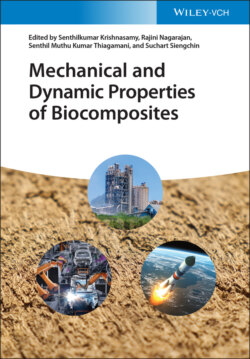Читать книгу Mechanical and Dynamic Properties of Biocomposites - Группа авторов - Страница 11
1.2 Concept of Natural Fibers and/or Biopolymers: Biocomposites 1.2.1 Natural Fiber‐Reinforced Polymer Composites or Biocomposites
ОглавлениеNatural fiber‐reinforced polymer (FRP) composites or biocomposites are gaining widespread interest for many reasons. One such reason is the fact that they have shown a potential for replacement of synthetic fibers at a lower cost. They are also sustainable when compared with their synthetic counterparts [5].
Natural fibers refer to fibers whose origins are natural, that is, they are sourced from plants and animals. These origins give rise to three fundamental natural fiber types, viz:
Animal fibers: These contain proteins, such as keratin, fibroin, and collagen. Other classifications in this category are animal wool/hairs (angora wool, alpaca, camel, mohair, lamb's wool, bison, yak wool, cashmere, horse hair, goat hair, and qiviut, among others), keratin fiber (chicken and bird feathers), and silk fibers (spider silk, tussah silkmoths, mulberry silk cocoons).
Plant fibers: These are often referred to as cellulosic or lignocellulosic fibers. They are classified in six categories:Seed/fruit fibers: Coir, coconut, loofah, cotton, oil palm, kapok, sponge gourd, milkweed hairs.Cane, grass, and reed fibers: Bamboo, corn, albardine, esparto, bagasse, sabai, papyrus, rape, canary.Bast or stem fibers: Blax, jute, okra, rattan, paper mulberry, hemp, kenaf, isora, urena, ramie, kudzu, roselle hemp, wisteria, mesta and nettle, among others.Wood fibers: Hardwood and softwood, among others.Leaf fibers: Caraua, pineapple, abaca, raphia, agave, caroa, banana, fique, piassava, cantala, sansevieria, phormium, Mauritius hemp, sisal, date palm, istle and henequen, to mention but a few.Stalk fibers: Derivable from barley stalk, rice stalk, maize stalk, wheat stalk, oat stalk as well as other crops. Table 1.2 shows the percentage weight (wt.%) of chemical compositions of the mostly used natural fibers.
Mineral fibers: These fibers include fibrous brucite, asbestos group (amosite, chrysotile, anthophyllite, crocidolite, actinolite and tremolite) and wollastonite.
Table 1.2 Commonly used natural fibers in hybrid composites and their chemical compositions.
Source: Faruk et al. [6]. © 2012, Elsevier.
| Fiber | Cellulose (wt.%) | Hemicellulose (wt.%) | Lignin (wt.%) | Waxes (wt.%) |
|---|---|---|---|---|
| Abaca | 56–63 | 20–25 | 7–9 | 3 |
| Bagasse | 55.2 | 16.8 | 25.3 | — |
| Bamboo | 26–43 | 30 | 21–31 | — |
| Coir | 32–43 | 0.15–0.25 | 40–45 | — |
| Curaua | 73.6 | 9.9 | 7.5 | — |
| Flax | 71 | 18.6–20.6 | 2.2 | 1.5 |
| Hemp | 68 | 15 | 10 | 0.8 |
| Jute | 61–71 | 14–20 | 12–13 | 0.5 |
| Kenaf | 72 | 20.3 | 9 | — |
| Oil palm | 65 | — | 29 | — |
| Pineapple | 81 | — | 12.7 | — |
| Ramie | 68.6–76.2 | 13–16 | 0.6–0.7 | 0.3 |
| Rice husk | 35–45 | 19–25 | 20 | 14–17 |
| Rice straw | 41–57 | 33 | 8–19 | 8–38 |
| Sisal | 65 | 12 | 9.9 | 2 |
| Wheat straw | 38–45 | 15–31 | 12–20 | — |
